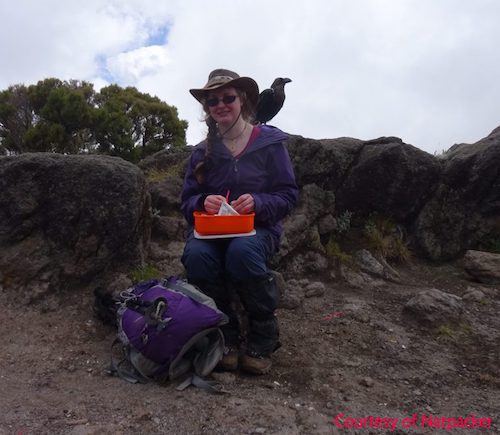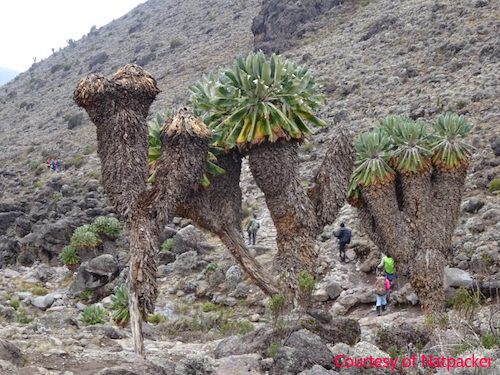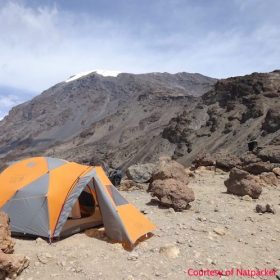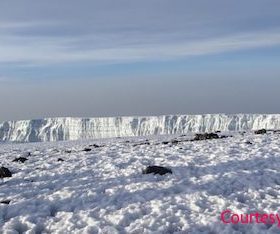This Embolden Adventures Kilimanjaro podcast is part of the travel series on Mount Kilimanjaro. In 2017, I will make my way to Tanzania in Africa to climb the tallest freestanding mountain in the world.
As I prepare for this feat, I had the chance to chat with Natalie Took of the travel blog Natpacker.com. On her site, Nat writes about the joys of backpacking around the world in an affordable way.
Nat climbed Mt Kilimanjaro in 2015 and chronicled her experience. Recently, Nat spent some time talking to me on this Embolden Adventures Kilimanjaro podcast about all things Kilimanjaro. In this episode, hear about:
- Who is Nat of Natpacker.com
- What to pack for the long adventure
- When to hike the summit
- Where to store your electronics including cameras
- Why the guides and porters are amazing
- How much to tip at the end of the adventure
- …and more!
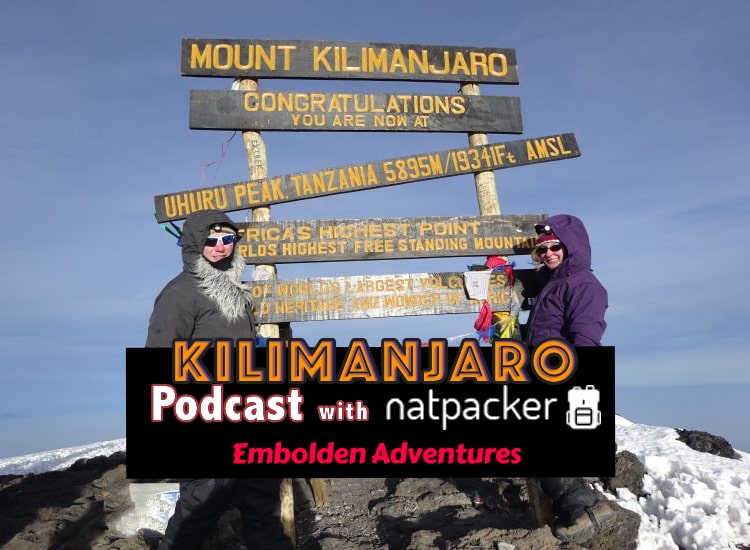
Check out this Kilimanjaro Podcast
An Embolden Adventure up Kilimanjaro
So what business does this New York City gal have climbing one of the tallest mountains in the world, Kilimanjaro? I don’t know either, but I am going to give it a shot this year.
Join me in my journey as I ready myself to summit this mountain along with friends from around the world. Check out the full Embolden Adventures Kilimanjaro experience here.
Mt Kilimanjaro, an old volcano, is the fourth most prominent peak in the world. Known as “Africa’s Rooftop”, it is the tallest point in all of the continent, standing at 19,341 feet.
This mountain climb is not like that of Mt Everest, only reserved for advanced mountaineers with appropriate climbing equipment. Basically, it is a long, gradual walk up a very tall mountain.
However, climbing Mt Kilimanjaro is still a difficult feat. High elevation can cause altitude sickness for even the best of hikers. Also, the occasional high winds and the cold temperatures can make the hike uncomfortable. While fatalities are rare – just a 0.01% chance – it is worth noting the dangers of falling rocks, slipping, and advanced altitude sickness.
Climbing to the top is both mentally and physically challenging. Hikers can expect to walk between 3 and 8 hours a day for up to 9 days in total. On the day of summiting, hikers can walk a total of 16 hours, starting in the middle of the night in temperatures as cold as -40 degrees Fahrenheit (-40 degrees Celsius).
To be successful in reaching the top, here are some things to keep in mind:
- Walk slowly
- Keep warm by dressing in appropriate clothing and in layers
- Stay hydrated
- Rest
- and travel with experienced guides and porters
Meet Nat
As I am in the midst of readying myself to embark on this epic hike, I came across Natpacker.com. Natalie Took is a backpacking world traveler and the creator of Natpacker. She hiked Kilimanjaro in 2015 and then published a fairly comprehensive chronicle of her journey.
I found Nat’s tips on how to prepare very helpful and enjoyed reading her journey.
So I invited her to have a chat on the Embolden Adventures Kilimanjaro podcast!
Nat was driven to hike Kilimanjaro, a bucket list experience for her. She and her now-husband Dave were about to celebrate their 10-year anniversary, so they wanted to do something spectacular for the occasion. Well, Kilimanjaro it was.
And there on the mountain, after 4 long days of hiking and before reaching the summit, Dave proposed to Nat on their anniversary. Although, because of the altitude, the ring didn’t fit!
I asked Nat why Kilimanjaro, and she said it was for the accomplishment and the spectacular views along the way.
“You feel such sense of achievement,” said Nat. As for the views, they are 360-degrees and ever changing. From rainforests to cactus, from rocky boulders to glaciers, the transition of the earth along the path is “truly amazing”.
Preparing and Packing
How to prepare.
For a feat this significant, should advance planning and training be necessary?
Well, Nat said that she did not do any proper training for the hike. She upped her usual running workout from once a week to twice a week. She did a few weekend climbs in the area including 3500 feet up Snowdon Mountain in Wales, United Kingdom.
According to Nat, what really pushes you up to the very top of Kilimanjaro is your mindset. “It is a lot of determination to get you up there, not just physical fitness. It is actually really wanting to do it.”
And having a strong mental stamina is key for having to walk 7 days straight: 5 up to the summit and 2 back down the mountain, in frigid temperatures, exhaustion, and low oxygen.
She goes on to say: “It is deciding that you are going to make it. If you have doubts that maybe you can’t do it, maybe this isn’t right, then you won’t manage it. It’s having that complete thought: ‘No, I am doing this. I am doing this. I am going to do this no matter what.’ That’s what pushes you to actually get up there, really. Just accept yah, I’m tired, I’m knackered, I feel like I can’t go on. But ‘no I want to do this. It’s my once in a lifetime chance of doing this, so I am doing this.’ It’s that determination that gets you up there.”
Of the main culprits that make this experience challenging, the altitude is the biggest of all. In just the second day on the mountain, Nat began to feel the effects of the altitude. The air is thinner thus providing less oxygen to the blood cells. Breathing becomes labored, especially walking up the inclined path at a normal pace. By the fourth day at the heights above the clouds, the temperatures would become very cold, the air very thin, and the altitude effects in full force.
Altitude sickness can cause a loss in appetite, lack of sleep, confusion, nausea, and more.
Typically people take Diamox to prevent the effects of altitude sickness, but Nat says to avoid the medication. The guides will tell you the same on the mountain. Nat took a Diamox pill one of the days and then felt the “worst pins and needles in her legs.” The side effects were so bad that she had trouble standing, let alone walking, for a half hour. As a result, she decided to deal with the altitude effects for the rest of the hike.
To keep altitude sickness at bay, maintain a very slow walking pace throughout the trek. “Pole Pole” the guides tell hikers all the time. In Swahili, it translates to “slowly slow”.
Also, hikers adjust to the altitude naturally by “hiking high and camping low”. In this pathway hikers climb up, and then descend down a bit to sleep, and then climb up some more the following day.
What to Bring.
As for what to bring on this journey into the clouds, Nat provided some great answers.
She wrote a comprehensive list of what to bring with you on this trip. In summary, the themes are merino wool and layers, layers and more layers of clothing. Also, here is a great post from Live Once Live Wild that describes the best travel backpack guide and gear ideas.
Pack two or three thermal base layers. Base layers made of merino wool material are best. Also, pack a few pairs of merino wool socks.
Bring fleeces, windbreaker jacket and pants, waterproof clothing and bag covers, hats, gloves, sunglasses, walking sticks, headlamp, batteries, and insect repellant. Having a sleeping mat under your sleeping bag is important too. I am going to pack a roll of toilet paper and other sanitary items just in case. Nat says don’t forget the wet wipes!
And bring gators! Well, not those alligators like I thought but gaiters. I never heard of gaiters before, so Nat explained that they are protective coverings for your shoes, ankles, and shins. Gaiters are great for hiking through the jungle on the first day. They are also good to wear again on the summit because they add an extra layer of warmth.
What About Your Camera and Other Electronics?
The cold temperatures are bound to drain your electronic batteries including your precious camera! Some tips to keep in mind to preserve your battery life:
- Fully charge all electronics the night before the hike
- Bring extra fully-charged batteries
- Be frugal with your photos
- Avoid looking at your pictures on the mountain
- Keep your camera close to your body to protect against the elements
- Bring a solar or micro wind charger
- Your iPhone or other smartphone may be useless
Although, wearing a camelback on a typical hike is useful, in this case, bringing a camelback may not be good. Nat said that the water in the tube would freeze as the temperatures drop and render the camelback useless.
Instead, bring two or three durable water bottles with you. The porters will provide 3 liters of drinking water to each person per day. They retrieve the water from the natural springs along the trail and boil it before drinking. To be extra careful, pop in a water purification tablet in your drinking water and sprinkle in rehydration power to replenish electrolytes and feel energized.
Regarding the tents and sleeping bags, the outfitter you choose for this hike provides these items for you. Check with your individual outfitter for details.
Most importantly, wear comfortable hiking boots that fit well. Break them in before hiking and make sure you have space for your toes to wiggle and breathe.
Nat suggests bringing a 75-liter backpack and a 30-liter day backpack. Both bags are soft and light for easy carry. The porters will carry your larger bag along the route while you will carry you day backpack filled with your necessities for the day. The porters are incredible in their ability to carry your larger bag, balanced on top of their head no less, up the entire mountain, save for the summit.
In your day backpack, pack the layers you will need throughout the day. Also include your waterproof and windproof shell, your water bottles, and your lunchbox of food provided by the porters. Keep the shell at the top of the backpack and your lunchbox in the middle of the pack. Lastly, keep your heaviest items at the bottom of the backpack. Click here to read what a US Army Ranger had to say about packing your backpack for your hike.
When to Hike
Ok so you are all set with your gear and your backpack packing, you are ready to hike. According to this guide, the best times to hike are January through March and again from June through October, the most popular times of the year. The rainy days are from March through April and again in November. The coldest months are from December through May. Try to time the journey during a full moonso it lights up your path at night.
Day One
In the first day, the pace felt very slow to Nat. The guides were adamant that you keep a slow pace so to not tire yourself for the journey. “Pole Pole!” By the time you ascend higher, you will find the guides were right all along. The slower you go the higher chance you have of success.
But do not move too slowly. Nat mentioned that the guides suggest layering your clothing as you go. Add layers as necessary at the time. If not, people will be slowing the pace by constantly stopping to take off and put on layers. The more you stop, the colder you become, so walk efficiently.
Surprisingly, some areas were hot during the day despite the high elevation, especially at the plateau before the summit. Nat said there she was walking around this area in just a fleece.
During the hikes, drink lots of water. You will be exerting energy in dry conditions and will get dehydrated. Drinking 3 liters of water a day, the equivalent to one and a half large plastic coke bottles, is sufficient. Also be sure to eat and eat some more. The porters bring all of your food and the chefs prepare really good, hot meals each day including soups, rice, and chicken. And they make sure you have seconds. Nat said you basically eat like a king while on the mountain.
Typically, hikers walk 7 to 8 hours a day on most days. In Nat’s schedule, her group hiked two half-days and had an extra night on the mountain before reaching the summit. They used the afternoons to rest up, readying themselves for the peak the following night.
Approaching the Summit
In the hours leading up to the summit hike, you will take a very long nap at the campsite. At around midnight, you gear up to begin the 16-hour long hike up to the 19,341-foot peak. Only the summiting porters and the guides join you on the ascent upward. However, the path is quite busy with the groups of hikers having converged from the other 5 routes up the mountain.
The summit hike itself is very challenging and physically demanding. The route is rocky. Temperatures and the winds are frigid, and the night sky is very dark. “The summit was absolutely freezing, I’ll tell you that”, says Nat. And you are climbing up the steepest part of the route in a short period of time.
Since the air is so thin at this height, you have to move at a snail’s pace so to not overexert yourself. Take four paces and stop to catch your breath. Take four more paces and stop again. “It took us hours and hours,” Nat noted. “It took lots of determination.”
She said, “It was so bizarre” that she was not able to remember much during the hike. The memories all came back to her afterward.
The group begins the walk at night for many reasons. First, for the surprising reason, it gets hot during the day. Because you exert so much energy at this point, having a lot of water is very important. And it helps to ease the effects of altitude. Therefore, walking at night preserves your drinking water since no natural water sources are located at the peak.
Secondly, if you saw the magnitude of this trail in the daylight, you may psych yourself out. It would be very easy to just quit at that point, especially when you are so exhausted. It could then become a life regret!
At one point, the summiting porter takes your day backpack and carries it for you in addition to his backpack. Also, he gives you hot tea and coffee that he brings with him. While it seems unfair they are doing all the work, these porters are more experienced and better acclimated to the altitude then you. They are there to help you reach the summit. “They are very impressive,“ Nat said.
Lastly, the guide times the hike at night so you can watch the sunrise over the glaciers. This sunrise is a gorgeous, unique experience that makes the entire effort to climb Kilimanjaro worth it. During the hike, you have about an hour to walk around the volcanic crater to see the views. It seems like another world.
And that is it! After taking your iconic picture at the peak, head back down the summit to the camp. The following day, you descend quickly to the base of the mountain. Nat said the terrain changes much more quickly on the way down, and you can definitely feel the difference in richer oxygen levels. “It was amazing.”
The Porters Are Worth Their Weight in Gold
Reaching the summit successfully is due in part to the outfitter you choose. Typically your group has a head guide, assistant guides, a chef and assistant chefs, and a number of porters per hiker. These people are worth their weight in gold, because they work really hard up the route. They carry your heavy bags (sometimes balanced on their head!), prepare your foods, set up your campsites, and administer first aid among other important actions. They can even tell when you are not feeling well before you realize it. Without them, your chances in reaching the top are slim.
Nat said that her guides were well traveled, noting that some visited the United Kingdom. The guides are local Tanzanians, and are trilingual, speaking their tribe language, the national language Swahili, and English. And they were all really fun said Nat.
The porters are very impressive. They carry big sacks of packed items and gear on their heads and then sprint past you on the route. The porters get to the campsites ahead of the group to set up the sleeping tents and the communal tents. They tend to not speak English and have limited interaction with the group.
The chefs prepare the meals for breakfast and dinner and pack individual lunches for each hiker to take with them.
These campsites are not actual campsites per se. Rather they are flat, cleared areas. Some have private, makeshift outhouses for bathrooms. However, you can go to the bathroom along the way off the beaten path if you so choose. That, or you can pay extra to have a porter carry your own makeshift toilet. I think I will opt for the nearby tree next to the large boulder!
Speaking about the campsites, Nat “found it shockingly more comfortable” than she imagined. Despite the comfort, the temperature at night becomes really cold. “You really had to get into sleeping bags. Getting up in the morning was the hardest thing” but it was still “strangely comfortable.”
And How Much is That Gold?
Since the guides and the rest of crew are so helpful in this journey, naturally one would want to extend a proper tip. Unfortunately, some are not earning a living wage in the job they do, so a tip goes a long way.
On this Kilimanjaro podcast, I asked Nat about tipping. She goes into the calculation here on her site.
She suggests tipping between US$70 and $80 per day from the group for a total of around $500 per person.
The tipping structure is tiered. From your group, the head guide receives about $30 per day, and the assistant guides receive about $25 per day. Your summiting porter receives about $20 per day, while your personal porter receives $15 per day. Other porters receive $12 per day. Lastly, the chefs receive about $20 per day.
Since Tanzania has a closed currency, exchanging your money for local currency is possible only inside the country.
Nat offers some advice: Try to tip as a group using only US dollars. They usually prefer US dollars since they have US-dollar bank accounts. Plus, figuring out conversion rates with multiple currencies from the group is a difficult especially when you are tired after a long trek.
One last bit of advice from Nat – have a look at the things she wish she knew before climbing Kilimanjaro including what trip insurance insures you to the summit!
And that’s a wrap! Thank you Nat for being on this Embolden Adventures Kilimanjaro podcast. Your story and advice are helpful. Let’s see if I make it to the top of Kilimanjaro! Stay tuned!


